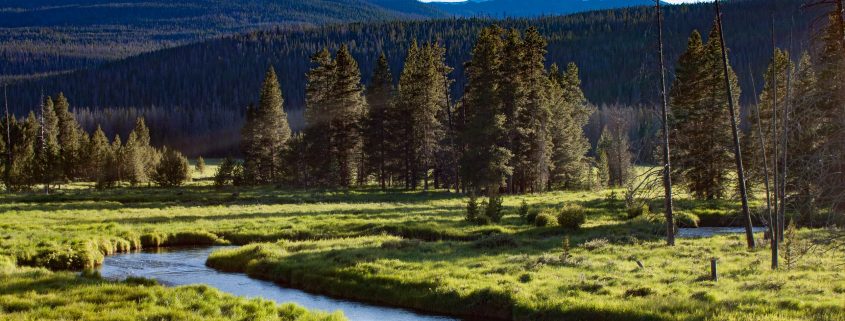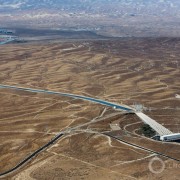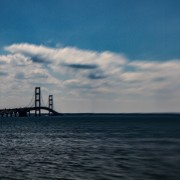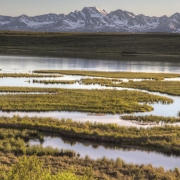U.S. Governors Discuss Water in 2017 State of the State Speeches
Leaders outline water policy priorities.
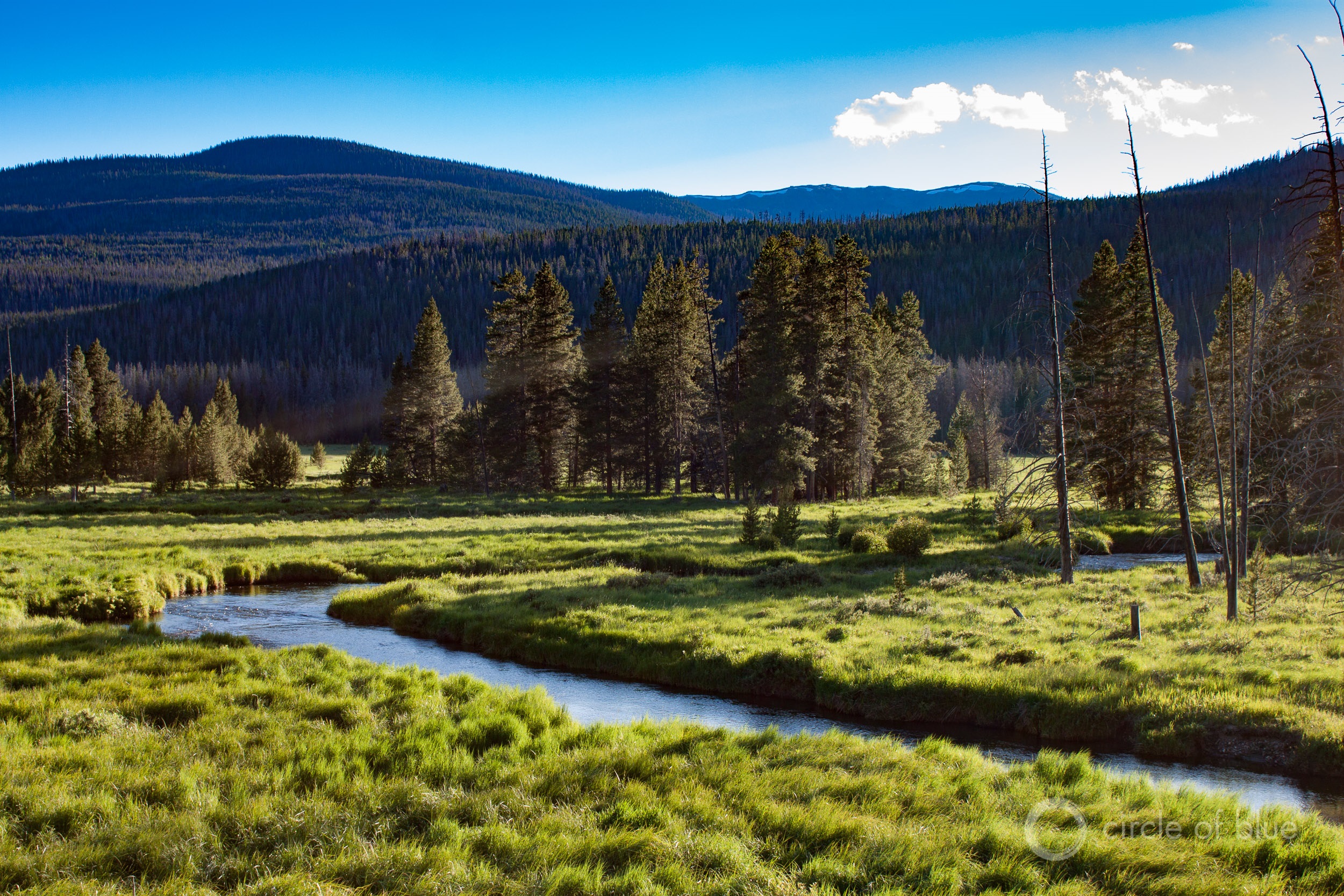
The Colorado River headwaters in Rocky Mountain National Park. Photo © Brett Walton / Circle of Blue
By Brett Walton, Circle of Blue
Akin to the presidential State of the Union, the State of the State speech is an opportunity for U.S. governors to set budget priorities for the upcoming year and champion public policy success (and occasionally failures).
Below are summaries of what governors said about water in their 2017 speeches. For many state leaders, water has enough urgency to merit discussion. Iowa, for one, continues to grapple with nitrate pollution while New York’s governor wants $US 2 billion to patch and repair water pipes and treatment facilities.
This post will be updated throughout speech season, which concludes on April 10 with Gov. John Bel Edwards of Louisiana.
Alaska
Like last year, the state budget deficit is foremost on Gov. Bill Walker’s mind. Low oil prices contributed to an 80 percent decrease in revenue over four years and a $US 3 billion spending gap.
Despite the fiscal gloom, the first-term governor highlighted an achievement in protecting the state’s salmon rivers from cross-border mining pollution. Walker praised an October 2016 agreement with British Columbia to monitor three watersheds in southeastern Alaska. As many as 10 hardrock mines are in various stages of development in British Columbia, upstream of productive salmon fisheries. Alaska’s congressional delegation has asked the U.S. State Department to involve the national governments, and fisheries groups want a binding bilateral treaty.
“Water does not recognize political borders,” Walker said. “I am committed to protecting our waters and the rich resources they support.”
The governor made a notable shift on climate change this year. After not mentioning climate at all in his 2016 address, Walker noted the severe effect that warming temperatures will have on the Arctic state. He called climate change “one of the greatest challenges of our era.”
“Alaskans have known for some time that our landscape is changing at an accelerating pace,” Walker said. “Alaska is the only Arctic state in the nation — and we are ground zero for climate impacts. We must maintain the integrity of our lands, air, and water for future generations. My administration is developing a framework to engage Alaskans in this effort to protect our way of life. We will seek out local and traditional knowledge. We will seek out industry input. We will seek to involve every sector to help us meet this challenge. It is one of the greatest challenges of our era. We look forward to working with you to create a legacy of timely response.”
And yet, current economics still guide government action. In this case, Alaska’s reliance on oil revenue. Walker also called for more drilling in Alaska National Wildlife Refuge, which could help fill idle pipelines.
“We have a three-quarters empty oil pipeline sitting within 50 miles of an estimated 10-billion-barrel oil reserve,” he said, referring to a 1.5 million-acre coastal section of the refuge. The U.S. Geological Survey estimates that the section holds between 4.2 billion and 11.8 billion barrels of oil.
“If the outgoing administration could see fit to allow offshore drilling, surely the incoming administration will see the wisdom of allowing onshore drilling in this area,” Walker surmised. “We have already reached out to the incoming President on this issue. Following consultation with those who live in the region, I will advocate tirelessly to bring this opportunity to reality.”
Colorado
Gov. John Hickenlooper, a Democrat, positioned himself, in broad strokes, as a leader who walks the line between resource development and protection. “We’ve protected thousands of acres of open lands and rivers,” he said. “While we’ve become one of the best states in the country for natural gas production.”
Hickenlooper also praised the state water plan, which was completed in 2015.
Delaware
Though known more for its beaches, Delaware is home to a relatively large agriculture industry. More than 40 percent of the state’s 1.2 million acres are farmland. And being in the Chesapeake Bay watershed means that the state has a mandate to reduce nutrient and sediment runoff. Gov. John Carney, a first-term Democrat, said that the state needs to help farmers find ways to keep nutrients in the soil. He did not provide details.
“Agriculture remains the bedrock of the Delaware economy,” Carney said. “The best way to preserve agriculture is to help family farmers be more profitable. One way we can do that is to help farmers in their nutrient management efforts to protect Delaware waterways. Our administration will work to develop better approaches to accomplish that objective.”
Hawaii
Gov. David Ige, a first-term Democrat, argued that policies that protect waters and forests are state priorities. He touted the Clean Energy Mandate, which requires 100 percent renewable electricity by 2045, and the Sustainable Hawaii Initiative that will preserve forests that are sources of drinking water.
Ige also proposed $US 18.4 million to guard the state’s waters, forests, and oceans from invasive species.
Idaho
Gov. Butch Otter, a third-term Republican, called for a larger state role in the management of public land, water, forests, and wildlife. Otter is “optimistic” that the Trump administration will work to keep federal agencies “in check,” but he said he does not support state control of public lands that are currently managed by the federal government.
“For years now,” Otter said, “we in the West have been frustrated by the increasing imposition of the federal government’s will over our livelihoods and quality of life. Regulatory bureaucracies and entrenched interests have become practiced at reaching far beyond the letter of such laws as the Clean Air Act, Clean Water Act and Endangered Species Act to essentially nullify the commonsense stewardship of states and local jurisdictions.”
Otter also recommended spending an additional $US 250,000 to address the risk of wildfire to watersheds and lauded a state water sustainability policy that the Idaho Water Resource Board completed last month.
Indiana
Gov. Eric Holcomb, a Republican and former lieutenant governor, was elected in November. He spoke broadly about the need to build a fourth port on the Ohio River and to develop a state water plan.
“As I think about the future, it also includes adding a fourth “water” port in Southeastern Indiana, which will help accelerate economic development and play to our strength in that beautiful part of our state.
We also have the responsibility to maintain and strengthen our basic infrastructure that is critical to our communities and our people and yet is showing the strain of age. This may not be sexy but it has to be done. We will pay special attention to our water needs and ensure we have a plan that’s efficient, sustainable, and affordable as we move forward.”
Illinois
Gov. Bruce Rauner, a first-term Republican, lauded a bill he signed just days earlier. The bill requires regular testing of drinking water for lead at schools and day care centers.
Iowa
As in 2016, Gov. Terry Branstad, a Republican and the longest-serving governor in U.S. history, prioritized the reduction of farm fertilizer pollution in the state’s waterways. A lawsuit filed in 2015 by the Des Moines Water Works, the capital city’s water provider, has pushed water quality near the top of the governor’s agenda. Branstad noted that legislative action from last year on paying for cleaner water will continue in 2017.
“Last year, I called on the Legislature to send me a water-quality improvement bill.
I was pleased to see bipartisan progress made on this front with the House passing House File 2541 last session. This bill was approved by the Agriculture, Ways and Means and Appropriations Committees and passed the House with 65 votes.
This bill provided for a long-term, dedicated and growing source of revenue to help implement projects to improve habitat and water quality directed by the Iowa Nutrient Reduction Strategy. The bill also provided funding for community conservation practices and improvements to wastewater and drinking water facilities.
By leading on this issue, together we have the opportunity to modernize Iowa’s agricultural infrastructure, create jobs in rural Iowa and promote collaboration between urban and rural communities.
I believe our discussions should begin with the House-passed bill from last session.
I hope we can work together to perfect and improve the legislation that will provide a long-term, dedicated and growing source of revenue for water-quality improvements.”
Kansas
Gov. Sam Brownback, a Republican, mentioned the importance of conserving water from the Ogallala Aquifer, one of his longstanding initiatives, but he did not go into detail.
“This Administration has focused efforts on solving long term issues facing our state like the need for more jobs — we’ve added 64,000 private sector jobs.
The need to preserve water resources — we’ve seen the life of the Ogallala Aquifer extended in some areas through conservation and new technology.
The need to expand wind energy production — we’ve seen $10 billion of wind investments brought to the prairie.”
Louisiana
Old infrastructure has led to drinking water problems in a number of Louisiana towns, but Gov. John Bel Edwards’ legislative priority is protecting the coast from erosion and hurricanes. The Democrat wants lawmakers to approve an updated 50-year restoration plan and a $US 644 million work plan for the upcoming fiscal year.
“We are in a race against time to save our coast, and it is time we make bold decisions now. I look forward to discussing these plans with the Legislature.”
Maryland
State programs to rid the Chesapeake Bay of pollutants and revive its fish and wildlife habitat were targets of praise in Gov. Larry Hogan’s address.
The first-term Republican governor’s main Chesapeake Bay goal for 2017 is a piece of legislation to jumpstart a market in water pollution trading. The Clean Water Commerce Act, which Hogan urged lawmakers to pass, would allocate $US 10 million to the program. The money would purchase credits generated by farms, cities, or industries that reduce pollution more than required by their permits. The money would come from the Bay Restoration Fund, which collects fees from sewer and septic systems.
“Together, we have been leading with bold initiatives to safeguard our environment.
In just our first few weeks in office, we successfully negotiated a compromise phosphorus management solution, which was a huge step toward protecting the Chesapeake Bay.
We invested the most ever in the Chesapeake and Atlantic Coastal Bays Trust Fund, and again this year, we are fully funding bay restoration efforts.
We restored $60 million previously drained from Program Open Space.
We pushed for landmark legislation that cemented our state’s position as a national leader in combating greenhouse gas emissions.
We enacted legislation expanding the Climate Change Commission.
And, after years of the problem being ignored, we are finally seeking innovative and cost-effective solutions to reduce the sediment, nitrogen, and phosphorus pollution which flows down the Susquehanna River over the Conowingo Dam and which is a serious threat to the Chesapeake Bay.
Just a few months ago on its latest annual report card, the Chesapeake Bay received its highest score for water quality in nearly a quarter century. The amount of nitrogen, phosphorus, and sediment in the bay has dropped dramatically compared to recent years.
We have been aggressive, proactive, and innovative in our efforts to safeguard Maryland’s environment.”
Michigan
Infrastructure. Wetlands. Drinking water. Carp. Gov. Rick Snyder covered a lot of ground in his address.
Snyder, a Republican, discussed a new program for wetlands, a rarity in a state of the state speech, calling them “vital to wildlife and infrastructure.” Michigan has lost some 4 million acres of wetlands in the last few decades, according to Snyder. He said that he would work with the Department of Natural Resources to develop a program to use state lands as wetland mitigation banks so that development on private lands could continue.
Snyder noted that invasive species such as Asian carp are a threat to the Great Lakes. He wants to “crowdsource” solutions, which the government will solicit through the Carp Challenge website.
The most resonant water issue in Michigan right now, however, is lead contamination in Flint. “Make no mistake, this was a sad chapter in the history of our state,” Snyder said. “Last year the people of Flint suffered an unacceptable crisis.” The water quality in Flint has improved, but it is not lead-free. Some $US 27 million in state funds have helped replaced 600 lead service lines, and Snyder said that he would work with the Legislature to propose a lead standard stricter than the federal rule.
Flint is not the only worry. “We’re at risk in every corner of Michigan for aging infrastructure,” Snyder remarked. He pointed to a sinkhole that opened near the town of Fraser in late December because of a busted sewer pipe.
Minnesota
Gov. Mark Dayton, a Democrat, defended state investment in education and infrastructure.
“Low taxes have never been Minnesota’s path to prosperity,” he said. “Instead, it is the public investments we have made with those tax revenues — especially in the educations of our citizens and the quality of our transportation and other infrastructure — that have been, and will continue to be, the keys to our citizens’ better standards of living.”
In his final term, Dayton has put the health of state waterways at the center of his legislative agenda.
“I have called for 2017 to be a year, during which we all pay special attention to the quality of our state’s water, which most of us assume we can take for granted,” Dayton said. He noted that pollution is taking a toll on state waters:
“Many of our state’s lakes, rivers, streams, and ditches have water that is unsafe for drinking, washing, commercial uses, and recreation.
And those problems are getting worse. What does it say about The Land of Sky Blue Waters when families can’t swim safely in nearby lakes? What does it say, when local rivers and streams are so polluted that fish and other wildlife cannot live in, or around, them?”
Mississippi
Gov. Phil Bryant, a Republican, asked lawmakers to establish a savings fund for the state’s remaining share of the BP oil spill settlement. That amounts to $US 110 million that can be used for future restoration projects.
Missouri
Gov. Eric Greitens, a Republican elected in November, said that the state needs to purge “frivolous regulations” and ordered a complete review of the rule book.
“Some rules are necessary to protect health and safety,” Greitens said. “But when government spends time enforcing frivolous regulations, important things like safe water and safe travel don’t get the time and attention they deserve.
I have ordered a complete review of every regulation in the state of Missouri. We’re going to reduce unnecessary and outdated regulations so that we can get back to creating good, quality, high-paying jobs.”
Montana
Gov. Steve Bullock, a Democrat, spoke about the need for infrastructure investment. He proposed $US 292 million for bridges, roads, water and sewer systems.
An advocate of public lands and outdoor recreation, the governor called for the protection of air, land, and water. “Let me be clear, again: do not send bills to my desk that even suggest or start down the path of transferring our public lands out of public hands,” he warned. “Because that will not happen — not on my watch.”
Bullock also said it was his duty as a public official and father to address climate change. He rejected the notion that addressing climate change means complete rejection of fossil fuels. This view is driven in large part by the state’s natural endowment. Like Alaska, which runs on oil revenue, Montana has a wealth of carbon-based energy: the country’s largest coal reserves. Bullock wants more state and federal investment in carbon capture technology. He asked lawmakers to authorize $US 3 million to join a carbon-capture test center established by Wyoming.
Nebraska
Nebraska this year marks its sesquicentennial, 150 years of statehood. Congratulations, Nebraskans!
Gov. Pete Ricketts, a Republican, is halfway through his first term. He wants “customer-focused state government.” The Department of Environmental Quality, he noted in his address, now has an online application for stormwater permits, which reduces wait times.
Ricketts also proposed an overhaul of state property taxes on farms. Instead of being based on market value of land, taxes would be set according to farm income. Ricketts said that eight Midwest states use a similar system.
Nevada
Outdoor recreation and natural resources were a big part of Gov. Brian Sandoval’s address. The two-term Republican announced the addition of three ranch properties along 28 miles of the Walker River to the state park system. He also proposed a new park at Tule Springs, near Las Vegas, and money to preserve Lake Tahoe’s renowned waters.
“We must continue the effort to preserve what Mark Twain called ‘surely the fairest picture the whole world affords,’ and my budget includes funding to fight aquatic invasive species, reduce the threat of wildfire and improve stormwater drainage. I don’t have to remind anyone about the duty we have to protect this awesome natural treasure and its world-famous clarity.”
Sandoval promised to continue the fight against storing nuclear waste at Yucca Mountain, a site proposed in the 1980s by the federal government as a nuclear dump. “Any attempt to resurrect the ill-conceived Yucca Mountain project will be met with relentless opposition and maximum resources,” he said.
Instead of nuclear waste, Nevada wants greater autonomy from the federal government to pursue mining riches, Sandoval said. The state has the only lithium mine in the country, and the governor called on the Trump administration to loosen restrictions on mining activity on public lands.
New Hampshire
New Hampshire is conducting a statewide investigation of chemical contamination of drinking water sources. The contaminants in question are perfluorinated compounds, which are used in nonstick cookware, firefighting foams, and stain-resistant carpet. Industrial facilities are one source but so are fire departments and military bases.
Gov. Chris Sununu, a first-term Republican, told the Legislature that protecting drinking water is a primary public health priority for his administration.
“There is no bigger public trust than every time we as citizens turn on that faucet. We trust that our government has done their job in ensuring clean water for us and our children.
Thanks to Senator Chuck Morse and his leadership in the Senate over the past few years, New Hampshire has protected the Drinking Water and Groundwater Trust Fund.
This fund of nearly $300 Million stands ready to be invested in vital infrastructure improvements across the state. Funds that can now be used in partnership with local communities to secure one of our most precious resources.”
New York
For Gov. Andrew Cuomo, a second-term Democrat, infrastructure is a primary concern. He proposes spending $US 2 billion in state money to overhaul old water systems.
“The next step in infrastructure is going to be protecting our water system. We have two problems on the water system: we have an old infrastructure and there are actually health hazards in our water systems because we did a lot of manufacturing for a lot of years.
There are a lot of toxins in the earth, which wind up in the groundwater, which have to be filtered. Especially for young children, they’re at risk — we need to take immediate action and I want to spend $2 billion to rebuild our water infrastructure across the state.
We want to fund state of the art drinking water treatment systems that filter out all potential chemicals that could be toxic and dangerous. Failing infrastructure pipes and protect drinking water at its source. I want local communities to work together to come up with the best, most cost efficient way to do it and project that plan to the state.”
North Carolina
He didn’t say much about it, but Gov. Roy Cooper, North Carolina’s first-term Democrat, did at least mention water.
“Being healthy also means clean air and water,” he said. “An emphasis on renewable energy can achieve that, and it will help our economy sustain good-paying jobs.”
The disposal of coal ash was a hot issue during Cooper’s campaign against Pat McCrory, who used to work at Duke Energy, the power company whose coal ash ponds are at the center of pollution lawsuits and criminal charges.
North Dakota
Gov. Doug Burgum, a Republican elected in November, promised a “fresh start” in the state’s relationship with Indian tribes following months of protest over the Dakota Access pipeline. Like the chairman of the Standing Rock Sioux, Burgum called for protestors to leave the camps on the Cannonball River so that the site can be cleaned up before spring floods.
“This crisis has lifted the veil of a troubled social fabric on the northern Great Plains. The history of American settlement and westward expansion contains many tragic episodes of broken promises, displaced native peoples, and forced assimilation.
It is in this context that the Standing Rock situation must be understood. This is not an issue that will simply go away after the pipeline is completed.
Trust has been eroded, and it will take time, effort and leadership to rebuild.
As a state government and as neighbors and citizens, we need to learn more and assume less about the histories and cultures within our borders.
I understand the state alone cannot “solve” the substantial and multi-generational problems in Indian Country.
America’s past cannot be changed. But we can acknowledge our history.And we can listen, with an aim to create mutually satisfying protocols of engagement and consultation.
As governor, I pledge my administration to a fresh start in our relations with all tribal nations who live with and among us.
This week we’ll begin meeting with the leaders of each tribe. Our goal is to understand each tribe’s individual issues and circumstances so that we may move forward together toward greater mutual respect, harmony and prosperity. We must work with resolve to shape a new future. It will require leadership from all sides, equipped with renewed empathy and humility.”
Ohio
Gov. John Kasich, a Republican, said that environmental protection is an economic investment. Clean water helps attract business, he stated. And in Ohio that starts with Lake Erie, whose algal blooms in recent years have become a poster for degraded waters.
“Yes, we want to make it cleaner,” Kasich said of the lake, “and we aim to keep it clean. And I hope those that come after me will realize this is the great, great jewel of the state of Ohio, and that’s the great Lake Erie.”
Kasich then touted a million-dollar grant that was approved the previous day to clean wetlands in Sandusky Bay.
“These are investments in water and natural resources, the quality of life,” he said. “But of course they’re also an investment in economic growth because we know that when we take care of the world around us it becomes another reason for job creators to want to put down roots here and want to grow.”
Oregon
Gov. Kate Brown, a Democrat, said that investments in water, particularly for irrigation, will “help rural Oregon thrive.” Brown included $US 32 million for rural water projects in her budget request. Brown also touted a law passed in 2016 to phase out the state’s use of electricity from coal-fired power plants by 2030.
South Carolina
Gov. Nikki Haley gave what could be her last State of the State speech. President-elect Donald Trump nominated Haley to be the U.S. ambassador to the United Nations.
Haley recalled the record-breaking floods in October 2015 and the damage last fall from Hurricane Matthew. She did not, however, mention her budget request for a one-time allocation of $US 4.8 million for dam safety. More than 75 dams failed in the last two years during floods.
Vermont
Gov. Phil Scott, a Republican who won election in November, promised to focus on clean water, both in waterways and in home faucets. He pledged to meet the requirements of Act 64, a water quality measure passed in 2015, but without raising taxes or fees.
“We must also meet our moral obligations, which includes, providing access to health care, protecting our environment and waterways, and ensuring all our citizens have safe, clean drinking water.
There’s no question, the change in Washington creates a level of uncertainty, but we have a strong team in place to respond. Here at home, our goal is to make healthcare more affordable and accessible for every Vermonter, and every business.
As I’ll detail in my budget address, we will work to give all Vermonters easy, reliable access and affordable options. Ensuring the health of our citizens also means making certain their drinking water is safe. I will continue to fight for those in Bennington County, impacted by the PFOA contamination. And I want them to know: I stand with you. I will ensure that your community is made whole, and all Vermonters are better protected.
We will also commit to the clean water goals we set in Act 64, and adhere to the standards we outlined with our federal partners. There are many approaches we can take to clean our affected waterways. I am confident that we can work together, within our existing resources, hand-in-hand with the agricultural community and municipalities.
We will uphold our obligations, but we will not fill this gap by raising taxes and fees. Vermonters do not have the capacity to pay more.”
Virginia
Gov. Terry McAuliffe, a Democrat, touted two items: a $US 50 million settlement with DuPont over mercury contamination of a Shenandoah River tributary and a $US 120 million federal grant to help the Tidewater region adapt to sea-level rise.
Washington
Gov. Jay Inslee’s budget calls for a carbon tax, estimated to generate $US 1 billion annually. However, the two-term Democrat, reelected in November, is unlikely to succeed. Washington voters rejected a carbon tax ballot initiative two months ago and Republican lawmakers say that his proposal is dead on arrival, even though Inslee suggested using some of the revenue to fund irrigation projects in eastern Washington, which is Republican territory.
West Virginia
Jim Justice, a Democrat, was sworn in as the state’s 36th governor on January 16. Justice is a character — a farmer, high school basketball coach, resort tycoon, and owner of a coal company fined for Clean Water Act violations in five states.
In his inaugural address, Justice noted that West Virginia faces “an incredible crisis” because of a drug epidemic, the collapse of the coal industry, and poor performance on any number of health and education scorecards. “I don’t like the fact that we’re fiftieth in everything coming and going,” he said.
Revenue has to be a part of renewal, Justice said. One remedy he frequently mentioned: turning the state’s natural resources, its trees, minerals, soil, and water, into money-making ventures. This can happen from tourism, he said. It can also happen through farming, mining, and the timber industry. If Idaho can grow potatoes and Vidalia, Georgia, can be known for an onion, then “we’ve got to identify our crop and market it right up the road to the two-thirds of the people” in the country that live within 500 miles of the state, he said.
“We’ve got to have jobs, we’ve got to have hope, we’ve got to have opportunity,” Justice proclaimed.
Wisconsin
The state is a hotbed for water issues — from lead in Milwaukee drinking water to shrinking lakes in the Central Sands region due to irrigation and manure pollution by large dairies on the Door Peninsula. But Gov. Scott Walker did not mention environmental or natural resources policy during his State of the State speech.
Wyoming
Much of Gov. Matt Mead’s address centered on closing a budget shortfall caused by the decline of coal and a slump in oil and natural gas prices. But the Republican governor also discussed the state water strategy, a plan issued two years ago that called for 10 new reservoirs in 10 years.
Mead said that an omnibus water bill to be considered by the Legislature includes funding for four of the 10 reservoirs. Together they will add 31,000 acre-feet of storage. “Water development must remain a priority,” Mead said.
Brett writes about agriculture, energy, infrastructure, and the politics and economics of water in the United States. He also writes the Federal Water Tap, Circle of Blue’s weekly digest of U.S. government water news. He is the winner of two Society of Environmental Journalists reporting awards, one of the top honors in American environmental journalism: first place for explanatory reporting for a series on septic system pollution in the United States(2016) and third place for beat reporting in a small market (2014). He received the Sierra Club’s Distinguished Service Award in 2018. Brett lives in Seattle, where he hikes the mountains and bakes pies. Contact Brett Walton

